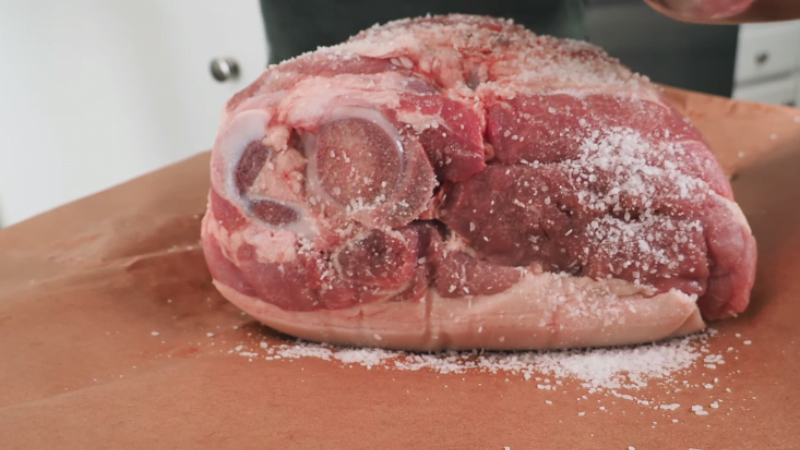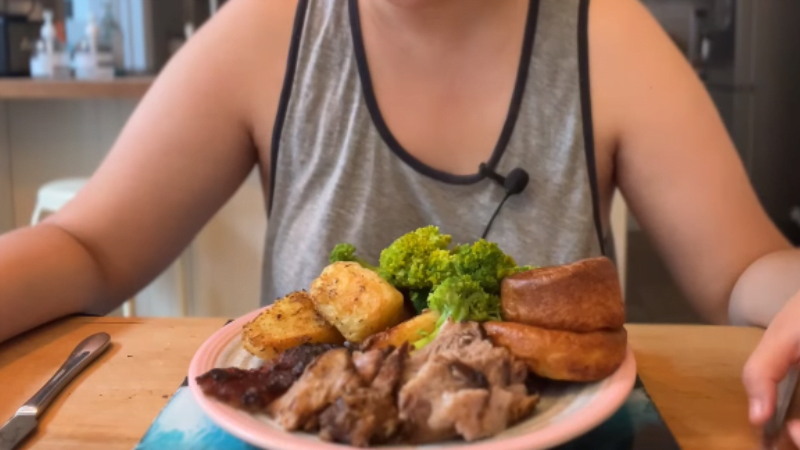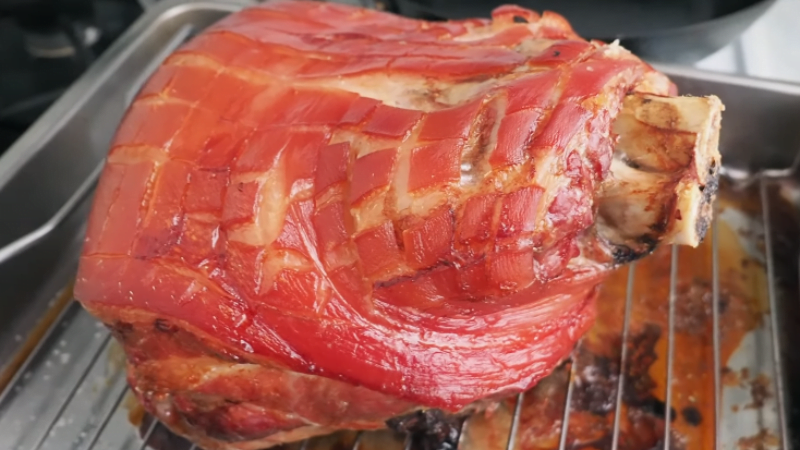Cooking pork shoulder at 250°F in the oven results in tender, flavorful meat that’s perfect for various dishes. In this guide, we’ll delve into the process of slow-cooking pork shoulder to perfection by answering the question “How long to cook pork shoulder in oven at 250?”
How Long To Cook Pork Shoulder In Oven At 250?
As a general guideline, a 2-3 pound pork shoulder typically takes around 6-7 hours to cook in oven at 250 degrees Fahrenheit. The rule of thumb is to allocate approximately 1 hour per pound of meat, but the exact cooking time may vary depending on the size of the pork shoulder.
Once the internal temperature reaches 145 degrees Fahrenheit, pork shoulder is cooked. Using a reliable meat thermometer, insert it into the thickest part of the pork shoulder to obtain an accurate reading.
What Is Pork Shoulder?
Pork shoulder, also called pork butt or Boston butt, is a substantial and well-marbled cut of meat derived from the upper region of a pig’s front leg. Known for its flavorful attributes, pork shoulder requires proper cooking techniques to achieve its tender and juicy potential.
Due to its inherent toughness, this cut is best suited for slow cooking methods, such as braising or roasting in the oven at low temperatures over an extended period. Its rich marbling ensures that the meat remains succulent and delivers a burst of savory goodness in every bite. Often utilized in classic dishes like pulled pork or enjoyed as a centerpiece for smoked barbecue feasts, pork shoulder’s high-fat content contributes to its exceptional flavor profile, making it a popular choice for meat lovers and culinary enthusiasts alike.
How To Cook Pork Shoulder In The Oven?
What do we need to cook pork shoulder in the oven?
Before embarking on the journey of cooking a mouthwatering pork shoulder in the oven, gathering all the essential ingredients and equipment is important. You’ll need a boneless pork shoulder roast weighing approximately 2-3 pounds to ensure a delectable result.
Additionally, have olive oil, salt, and pepper on hand to season the meat to perfection. A suitable ovenproof baking dish or roasting pan is necessary to accommodate the pork shoulder during cooking. For an extra burst of flavor, consider having herbs and seasonings such as paprika, garlic powder, chili powder, and brown sugar available to enhance the taste of the meat. A reliable meat thermometer is essential to monitor the pork shoulder’s internal temperature accurately.
Finally, a roasting pan with a rack and aluminum foil will help facilitate even cooking and protect the meat’s moisture. Optional ingredients, such as BBQ sauce, can complement the pork shoulder’s flavor profile. With these ingredients and equipment at your disposal, you’re ready to embark on a culinary adventure resulting in a tender, flavorful pork shoulder roasted to perfection.
- 2-3 pounds of Boneless pork shoulder roast
- Olive oil
- Salt
- Pepper
- Paprika
- Garlic powder
- Chili powder
- Brown sugar
- BBQ sauce
- Meat thermometer
- Roasting pan with rack
- Aluminum foil
How to slow cooking the pork shoulder in the oven?
Cooking a delicious pork shoulder in the oven is a flavorful and satisfying culinary endeavor. With a few simple steps, you can achieve tender and juicy results that will leave your taste buds longing for more. Here’s a straightforward guide to cooking the pork shoulder in the oven:

- Preheat your oven to 250 degrees F, ensuring it reaches the desired temperature for optimal cooking.
- Take your boneless pork shoulder, and place it in an ovenproof baking dish or roasting pan.
- Generously season your pork shoulder in rub with salt and pepper, allowing the seasoning to enhance the meat’s flavor. Drizzle olive oil over the pork to add moisture and enrich the taste.
- Cover the pork shoulder with aluminum foil, creating a sealed environment that helps retain moisture during cooking.
- Carefully place the pork shoulder in the preheated oven and let it cook for approximately 4 hours. As a general guideline, calculate around 40-45 minutes per pound of meat to ensure thorough cooking.
- After the initial 4 hours of cooking, remove the foil to expose the pork shoulder. Return it to the oven and continue cooking for an additional 2 hours at 250 degrees Fahrenheit. This extended cooking time allows the meat to develop a beautifully caramelized exterior while remaining juicy and succulent pork inside.
- Use a meat thermometer to check the internal temperature to ensure the pork shoulder is perfectly cooked. The target temperature should reach 160 degrees Fahrenheit, indicating that the meat is cooked and ready to eat. This temperature ensures a balance between tenderness and doneness.
- Once the pork shoulder has reached the desired temperature, remove it from the oven and let it rest for 10-15 minutes. Allowing the meat to rest ensures that your pork has the juices redistributed, resulting in a more succulent final product.
- With the resting period complete, it’s time to slice the pork shoulder into delectable portions and serve.
Cooking pork shoulder in the oven at a low temperature over an extended period is a fantastic way to achieve a melt-in-your-mouth experience.
What To Eat With When You Have Pork Shoulder?
The succulent flavors of a perfectly cooked pork shoulder can be enhanced and complemented by a variety of side dishes. Classic options include roasted potatoes, whether crispy on the outside or fluffy on the inside, providing a delightful contrast to the tender meat.

For a burst of color and nutrition, consider pairing the pork shoulder with a medley of roasted vegetables. The combination adds depth and texture to the dish, whether it’s caramelized Brussels sprouts, tender carrots, or roasted root vegetables. A fresh and vibrant salad, tossed with your favorite greens, along with fruits, nuts, or cheeses, can provide a refreshing and crisp component to balance the richness of the pork.
Various sauces and condiments can be utilized to elevate the flavors even further. A classic barbecue sauce enhances the smoky and savory notes of the pork, while a rich and flavorful gravy complements its juiciness. A zesty chimichurri sauce or a creamy horseradish sauce can provide an exciting flavor contrast for those seeking a tangy kick.
Adding herbs and spices to the pork shoulder before cook a pork shoulder can further enhance its taste profile.
How To Choose Good Pork Shoulder?
- Look for marbling and flexibility: The intermingling of fat within the muscle adds moisture and flavor, contributing to a more succulent end result. Additionally, gently press and feel the pork shoulder for flexibility. It should give slightly when pressed, indicating tenderness.
- Check the firmness and color: Steer clear of pork shoulder cuts that feel excessively firm or have color changes. Firmness can indicate toughness, while the color will tell whether the pork is fresh or not.
- Consider the size: The size of the pork shoulder depends on your specific cooking needs and preferences. For traditional pork shoulder, a weight of 3-4 pounds is commonly recommended. This size is suitable for various cooking methods, including roasting in the oven. If you prefer boneless pork shoulder, aim for a weight range of 6-8 pounds. Remember, the size of the cut will influence the cooking time and the number of servings.
- Check the use-by date: Before purchasing, always inspect the use-by date on the packaging to ensure the pork shoulder is fresh and within the recommended consumption timeframe.
Bone In versus Boneless Pork in pork shoulder cook
| Bone-in pork shoulder | Boneless pork shoulder |
| Refers to the cut that includes the shoulder blade bone. | Offers convenience and ease of preparation. |
| Adds flavor to the meat during the cooking process. | Easier to handle and carve after cooking. |
| Can contribute to a richer taste. | More versatile in terms of cooking methods. |
| Distribute heat more evenly. | Allows for more flexibility in seasoning and flavoring the meat. |
| Help retain moisture and enhance tenderness. |
Whether you choose bone-in or boneless pork shoulder depends on personal preference and the specific recipe or cooking technique you plan to use. Both options can yield delicious results, so consider factors such as convenience, desired flavors, and the cooking method you prefer when cook your pork shoulder. You may want to know about what is pork steak – a common cut of pork shoulder.
Nutrition Of Pork Shoulder

Pork shoulder in an oven is a rich source of protein, with a 3-ounce serving providing approximately 18 grams of this essential nutrient. Protein is crucial for building and repairing tissues, supporting muscle development, and promoting overall growth and maintenance of the body.
Pork roast shoulder contains important minerals, including iron, zinc, and selenium. Iron is vital for transporting oxygen throughout the body, while zinc plays a role in immune function and wound healing. Selenium acts as an antioxidant, helping protect cells from damage.
Pork shoulder is a good source of several B vitamins, including thiamin (vitamin B1), vitamin B6, and niacin (vitamin B3). These vitamins play various roles in energy metabolism, brain function, and maintaining healthy skin and nerves.
A 3-ounce serving of pork shoulder provides roughly 160 calories. It contains about 10 grams of fat, which includes both saturated and unsaturated fats. The presence of fat contributes to the meat’s flavor and helps keep it moist during cooking. Pork shoulder is also low in carbohydrates, with approximately 1 gram per serving.
Incorporating pork shoulder into a balanced diet can provide a significant boost of protein and essential nutrients. However, it’s essential to be mindful of portion sizes and choose cooking methods that minimize added fats or excessive sodium.
How To Store The Pork Shoulder Left Over?
To ensure the longevity of your leftover pork shoulder, proper storage is key. Start by allowing the cooked pork shoulder to cool to room temperature. This step helps prevent condensation and moisture buildup during storage. Once cooled, transfer the leftover pork shoulder to an airtight container or wrap it tightly in plastic wrap or aluminum foil. Place the container or wrapped pork shoulder in the refrigerator, where it can be stored for up to three days.
If you plan to keep the leftover pork shoulder for an extended period, freezing is an excellent option. Ensure it is tightly wrapped with plastic wrap or aluminum foil to prevent freezer burn. Place the wrapped pork shoulder in a freezer-friendly bag or container, removing as much air as possible. Label the packaging with the date for easy reference. Frozen pork shoulder can be stored for up to three months.
When you’re ready to enjoy the leftover pork shoulder, there are a couple of options for reheating. One simple method is to preheat the oven to 350 degrees Fahrenheit. Place the pork shoulder in an ovenproof dish, cover it with foil to retain moisture, and bake until heated through. The exact reheating time will depend on the size and thickness of the pork shoulder, but it typically takes about 20-30 minutes.
FAQs
Should I brine the pork shoulder before cook it?
Brining the pork shoulder before cooking is optional but can be beneficial. Brining involves soaking the meat in a solution of salt, sugar, and water, which helps enhance flavor and moisture retention. It can result in a more flavorful and tender pork shoulder, particularly if you prefer a juicier end result.
How to do a rub for pork shoulder?
Brown sugar, paprika, garlic powder, and chili powder should be mixed in equivalence to create a rub. A few teaspoons of olive oil should be added after the dry ingredients have been thoroughly blended. Then, before cooking, you can generously sprinkle this rub all over the pork shoulder.
What are other temperature to cook pork shoulder?
For slightly faster cooking, pork shoulder can be cooked with around 275-300°F. Alternatively, for a more accelerated cooking process, you can increase the temperature to 350°F or higher, but this may too hot for pork shoulder, result in a slightly different texture and flavor profile.
References:
- Boston butt – Wikipedia – https://en.wikipedia.org/wiki/Boston_butt
- WikiFandom – https://recipes.fandom.com/wiki/Pork_shoulder_and_blade






![What To Pair With Quiche? 25+ Best Dishes [With Pictures]](https://www.edithsbistro.com/wp-content/uploads/2024/04/what-to-pair-with-quiche-160x90.jpg)
